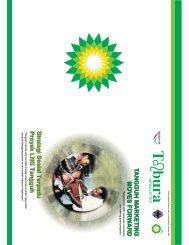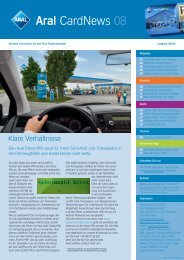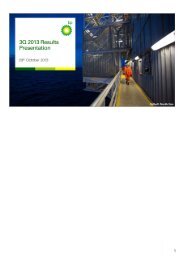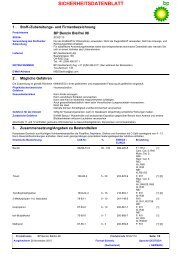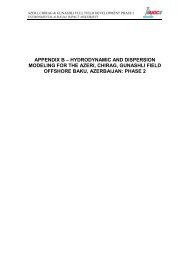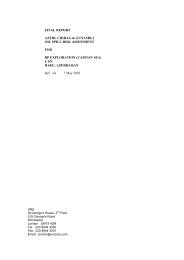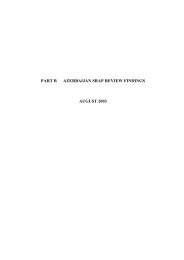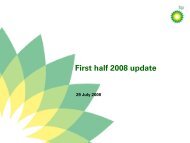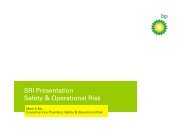Don Field Decommissioning Programme (pdf, 7.8MB) null - BP
Don Field Decommissioning Programme (pdf, 7.8MB) null - BP
Don Field Decommissioning Programme (pdf, 7.8MB) null - BP
Create successful ePaper yourself
Turn your PDF publications into a flip-book with our unique Google optimized e-Paper software.
<strong>Don</strong> <strong>Field</strong> <strong>Decommissioning</strong> <strong>Programme</strong>DON-<strong>BP</strong>-001Since the rate of oil loss and the persistence are well below the thresholds set byOSPAR, and no other discharges have contaminated the cuttings pile, no further actionis required and the cuttings pile may be left in situ to degrade naturally.5 <strong>Decommissioning</strong> OptionsIt is recommended that drill cuttings are left in place, with minimal disturbancebeing anticipated during any of the activities associated with the decommissioning of the<strong>Don</strong> <strong>Field</strong>. As the cuttings are minimal [8.1], it is proposed to wait until the subseafacilities have been removed before undertaking another full survey. This postdecommissioningstudy will have a design and sampling regime compatible with the July1999 study, so that the July 1999 study can be used as a baseline.The risks associated with general marine discharges and noise that may arise throughthe use of a survey vessel over the period of decommissioning studies would belocalised, and of a small scale and duration. The energy used and atmospheric emissionsgenerated would be because of fuel used by the survey vessels for ongoing monitoring.The potential for spreading of the pile by natural forces over a wider area has beenconsidered. Dispersion has already taken place since the cessation of drilling in 1991,with the 1999 survey [8.1] estimating that only 1763m 3 of the original 14,000m 3ofcuttings remain. The potential for leaching of hydrocarbons and/or other chemicals intoseawater has also been considered with the cumulative impacts considered minimal,as the field (and so the cuttings volume) is small in comparison to many others.The effect of long-term persistence of cuttings on the seabed is considered minimal.6 ConclusionsThe Scientific Review Group of the Oil & Gas UK (OGUK) Drill Cuttings Initiative [8.5]concluded that, at present, effects of drill cuttings piles across the North Sea are foundto be highly localised with the spatial extent of the areas affected being a smallpercentage of the total area of the North Sea.Hydrocarbons within the piles are considered to be largely immobilised and are onlybeing removed by erosion, degradation and leaching over several decades. Consideringthe wider environment, the rate of release is considered small in comparison tohydrocarbons entering the North Sea from other sources (in total 330 tonnes per year,which equates to less than 5% of the total annual hydrocarbons from other sources).In addition, after 30 years of cuttings discharges the total area of seabed resulting inbiological disturbance due to cuttings piles was estimated to be 1.605km 2or 0.23% ofthe total area of the North Sea. In comparison, fishing, dredging and spoil dumping isreported to affect an area of 130,000km 2 to 369,000km 2 per year, which translates to upto 50% of the total area of the North Sea [8.5].Due to the low volume of cuttings accumulation at the field, and the effect of naturalerosion and degradation, the recommendation to leave the <strong>Don</strong> <strong>Field</strong> drill cuttings inplace is both fit for purpose and sensible.Drill CuttingsMay 2011 8-5




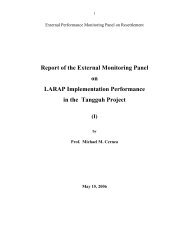
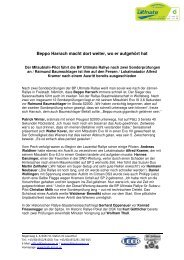
![[PDF] Deepwater Horizon: Accident Investigation Report - BP](https://img.yumpu.com/51697031/1/190x245/pdf-deepwater-horizon-accident-investigation-report-bp.jpg?quality=85)
